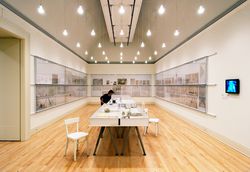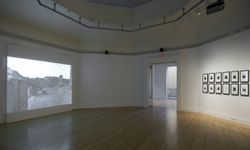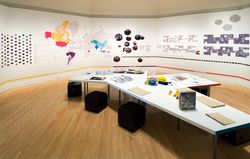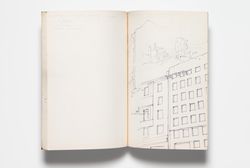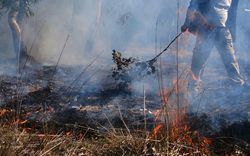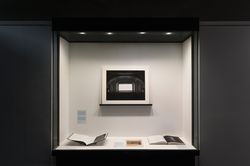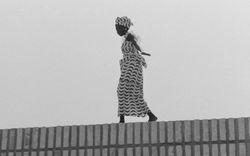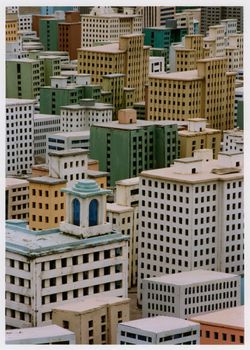archives
Niveau de description archivistique:
Fonds
Fonds Kenneth Frampton
AP197
Résumé:
The Kenneth Frampton fonds, 1958-2016, documents the professional career of Kenneth Frampton – British architect, historian, theorist, and Ware professor of Architecture at the Graduate School of Architecture, Planning and Preservation (GSAPP) at Columbia University. Materials in the fonds consist of approximately 28.37 l.m. of textual records, 3966 photographs and prints, 3168 postcards, 2733 slides, 824 drawings (including reprographic copies), 470 negatives, 151 35 mm negatives, 105 posters, 30 objects, 23 audio cassettes, 18 VHS tapes, 15 transparencies, 3 tape reels, 2 microfilms, and 2 vinyl records.
1958-2016
Fonds Kenneth Frampton
Actions:
AP197
Résumé:
The Kenneth Frampton fonds, 1958-2016, documents the professional career of Kenneth Frampton – British architect, historian, theorist, and Ware professor of Architecture at the Graduate School of Architecture, Planning and Preservation (GSAPP) at Columbia University. Materials in the fonds consist of approximately 28.37 l.m. of textual records, 3966 photographs and prints, 3168 postcards, 2733 slides, 824 drawings (including reprographic copies), 470 negatives, 151 35 mm negatives, 105 posters, 30 objects, 23 audio cassettes, 18 VHS tapes, 15 transparencies, 3 tape reels, 2 microfilms, and 2 vinyl records.
archives
Niveau de description archivistique:
Fonds
1958-2016
À partir d’hypothèses et de points de vue différents, Cedric Price, Aldo Rossi, James Stirling et Gordon Matta-Clark se sont engagés dans un processus de reformulation radicale du statut, de l’histoire et du rôle de l’architecture. sortis du cadre: price rossi stirling + matta-clark fait entrer en dialogue les réflexions de quatre figures marquantes des années 1970 à(...)
Salles principales
23 octobre 2003 au 6 septembre 2004
sortis du cadre : price rossi stirling + matta-clark
Actions:
Description:
À partir d’hypothèses et de points de vue différents, Cedric Price, Aldo Rossi, James Stirling et Gordon Matta-Clark se sont engagés dans un processus de reformulation radicale du statut, de l’histoire et du rôle de l’architecture. sortis du cadre: price rossi stirling + matta-clark fait entrer en dialogue les réflexions de quatre figures marquantes des années 1970 à(...)
Salles principales
L’artiste conceptuel britannique Victor Burgin exerce une grande influence à la fois comme artiste et comme théoricien de l’image statique et mobile. Commandé par le CCA, Voyage en Italie comprend deux séries de photographies en noir et blanc, de même qu’une vidéo évocatrice, qui illustrent la beauté intemporelle et la résonance d’une photographie du XIXe siècle de Carlo(...)
Salle octogonale
7 décembre 2006 au 25 mars 2007
Victor Burgin : voyage en Italie
Actions:
Description:
L’artiste conceptuel britannique Victor Burgin exerce une grande influence à la fois comme artiste et comme théoricien de l’image statique et mobile. Commandé par le CCA, Voyage en Italie comprend deux séries de photographies en noir et blanc, de même qu’une vidéo évocatrice, qui illustrent la beauté intemporelle et la résonance d’une photographie du XIXe siècle de Carlo(...)
Salle octogonale
Vie dans l'éponge
Simmons Hall est une résidence universitaire primée, conçue par l’architecte Steven Holl, sur le campus du Massachusetts Institute of Technology (MIT) à Cambridge. Inspiré d’une éponge de mer et de son concept de porosité, l’immeuble se distingue autant par sa structure audacieuse que par son objectif de favoriser l’interaction sociale. Vie dans l’éponge est une étude(...)
Salle octogonale
10 août 2006 au 19 novembre 2006
Vie dans l'éponge
Actions:
Description:
Simmons Hall est une résidence universitaire primée, conçue par l’architecte Steven Holl, sur le campus du Massachusetts Institute of Technology (MIT) à Cambridge. Inspiré d’une éponge de mer et de son concept de porosité, l’immeuble se distingue autant par sa structure audacieuse que par son objectif de favoriser l’interaction sociale. Vie dans l’éponge est une étude(...)
Salle octogonale
Le chercheur en résidence Gregorio Carboni Maestri présente sa recherche. Des années 1930 à la fin des années 1980, l’architecture portugaise s’est construite sur une relation frustrante avec la modernité, et sur un dialogue crucial avec l’Italie. Ce séminaire portera sur la façon dont l’architecture portugaise a observé les modèles italiens et y a réagi, notamment le(...)
Maison Shaughnessy Mot(s)-clé(s):
Gregorio Carboni Maestri, chercheur en résidence, Portugal, Tendenza
3 août 2017, 18h
Séminaire de chercheur en résidence : Gregorio Carboni Maestri
Actions:
Description:
Le chercheur en résidence Gregorio Carboni Maestri présente sa recherche. Des années 1930 à la fin des années 1980, l’architecture portugaise s’est construite sur une relation frustrante avec la modernité, et sur un dialogue crucial avec l’Italie. Ce séminaire portera sur la façon dont l’architecture portugaise a observé les modèles italiens et y a réagi, notamment le(...)
Maison Shaughnessy Mot(s)-clé(s):
Gregorio Carboni Maestri, chercheur en résidence, Portugal, Tendenza
articles
Les contre-récits du care
Figurer un territoire
14 novembre 2022
Les contre-récits du care
Michaela Prunotto en conversation avec Loving Country. Photographies de Vicky Shukuroglou
Actions:
Figurer un territoire
Miroirs / Mirrors
Miroirs/ Mirrors prend forme à travers un dialogue indirect avec l’exposition L’histoire, par ailleurs: Go Hasegawa, Kersten Geers, David Van Severen, qui prend racine dans les références et les résonnances partagées entre les travaux de deux pratiques contemporaines mises en présence de l’histoire. Alors que L’histoire, par ailleurs se fonde sur limpression que lon a du(...)
Vitrines
22 juin 2017 au 14 janvier 2018
Miroirs / Mirrors
Actions:
Description:
Miroirs/ Mirrors prend forme à travers un dialogue indirect avec l’exposition L’histoire, par ailleurs: Go Hasegawa, Kersten Geers, David Van Severen, qui prend racine dans les références et les résonnances partagées entre les travaux de deux pratiques contemporaines mises en présence de l’histoire. Alors que L’histoire, par ailleurs se fonde sur limpression que lon a du(...)
Vitrines
Projet
AP148.S1.1970.PR02
Description:
The project series documents Poli's work on the Interplanetary Architecture project, which was also made into a film by Superstudio directed by Alessandro Poli (the film is not included in the fonds). The project reflects Poli's deep fascination with the moon landing in 1969. Poli uses this major media event as a catalyst for thinking about a new approach to architecture and tools for design, including the idea that film and the movie camera should become part of the toolset. The project also seems to be in some way a response to Epoch magazine's challenge for a "Primo concorso di architettura nello spazio" (the first architectural competition in space), and includes much imagery and textual references to a new road or architectural links between the earth and other planets, including an earth moon highway. In his storyboard, Poli also makes reference to his earlier Piper project, and some imagery features wheels and an amusement park. The Interplanetary Architecture project was exhibited by Superstudio in Rome in 1972 and featured in "Casabella" magazine in April 1972 (no. 364). The project was also featured in the 2010 CCA exhibition "Other Space Odysseys". In the accompanying CCA publication, Poli describes this project as "a voyage off earthbound routes in quest of architecture unfettered by the urban nightmare, by induced needs or by planning as the only tool for regulating and solving the world's problems" (Poli quoted in Borasi and Zardini, 2010, 110). Poli's work on this project is deeply tied to the Zeno project, which was also featured in this exhibition and is included in this fonds (see AP148.S1.1972.PR01). For the Zeno project, Poli envisioned a dialogue between astronaut Buzz Aldrin and an Italian peasant, Zeno of Riparbella. Poli felt that these two shared a similarity in that both their homes were isolated capsules, one that provided a lens from which to see the rest of the world and understand their place in it. The material in the series includes numerous photomontages and collages of astronauts in space, as well as drawings of plantery shapes and structures. There are also texts, some of which include calculations of distances and diameters of planets, as well as notebooks and sketchbooks, many of which Poli included in a folder he entitled "Storyboard." The series also includes an unsent letter from Poli to Adolfo Natalini which describes how, after the moon landing, everything - the planet, the moon, the stars - is architecture, and that this will necessitate the need for new design tools, such as the movie camera. Some works are signed Alessandro Poli-Superstudio. Source cited: Giovanna Borasi and Mirko Zardini, eds., Other Space Odysseys, Montreal and Baden: Canadian Centre for Architecture/Lars Müller Publishers, 2010.
1969-1971
Architettura Interplanetaria [Interplanetary Architecture] (1970-1971)
Actions:
AP148.S1.1970.PR02
Description:
The project series documents Poli's work on the Interplanetary Architecture project, which was also made into a film by Superstudio directed by Alessandro Poli (the film is not included in the fonds). The project reflects Poli's deep fascination with the moon landing in 1969. Poli uses this major media event as a catalyst for thinking about a new approach to architecture and tools for design, including the idea that film and the movie camera should become part of the toolset. The project also seems to be in some way a response to Epoch magazine's challenge for a "Primo concorso di architettura nello spazio" (the first architectural competition in space), and includes much imagery and textual references to a new road or architectural links between the earth and other planets, including an earth moon highway. In his storyboard, Poli also makes reference to his earlier Piper project, and some imagery features wheels and an amusement park. The Interplanetary Architecture project was exhibited by Superstudio in Rome in 1972 and featured in "Casabella" magazine in April 1972 (no. 364). The project was also featured in the 2010 CCA exhibition "Other Space Odysseys". In the accompanying CCA publication, Poli describes this project as "a voyage off earthbound routes in quest of architecture unfettered by the urban nightmare, by induced needs or by planning as the only tool for regulating and solving the world's problems" (Poli quoted in Borasi and Zardini, 2010, 110). Poli's work on this project is deeply tied to the Zeno project, which was also featured in this exhibition and is included in this fonds (see AP148.S1.1972.PR01). For the Zeno project, Poli envisioned a dialogue between astronaut Buzz Aldrin and an Italian peasant, Zeno of Riparbella. Poli felt that these two shared a similarity in that both their homes were isolated capsules, one that provided a lens from which to see the rest of the world and understand their place in it. The material in the series includes numerous photomontages and collages of astronauts in space, as well as drawings of plantery shapes and structures. There are also texts, some of which include calculations of distances and diameters of planets, as well as notebooks and sketchbooks, many of which Poli included in a folder he entitled "Storyboard." The series also includes an unsent letter from Poli to Adolfo Natalini which describes how, after the moon landing, everything - the planet, the moon, the stars - is architecture, and that this will necessitate the need for new design tools, such as the movie camera. Some works are signed Alessandro Poli-Superstudio. Source cited: Giovanna Borasi and Mirko Zardini, eds., Other Space Odysseys, Montreal and Baden: Canadian Centre for Architecture/Lars Müller Publishers, 2010.
Project
1969-1971
articles
Huda Tayob, Centrer l'Afrique, La Noire de…, Ousmane Sembène, Frantz Fanon, Dakar, Antibes
22 mars 2021
Lire l’architecture à travers La Noire de...
Huda Tayob présente le film comme une archive incarnée et une critique de la ville en modernisation
Actions:
Théâtre Paul-Desmarais
27 septembre 2007
Théâtre Paul-Desmarais
